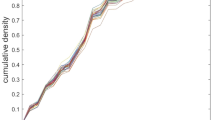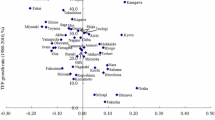Abstract
This paper examines the efficiency in resource allocation in China. We estimate production functions at the provincial level and use these functions to compute time series for marginal products of capital and labor. We found that dispersion in the marginal product of capital declined from 1970 to 1984 and then became stable afterward, whereas the dispersion in the marginal product of labor declined initially but the trend has been reversed since 1993. We argue that this reversal may indicate any of the following: (1) policy-driven labor migration adding to labor market inefficiency; (2) the presence of increasing returns in labor; and (3) both capital and labor having become mobile since 1993.
Similar content being viewed by others
References
Barro R. J. and Xavier Sala-i-Martin, Convergence across US states and regions, Brookings Pap. Econ. Act., 1991, I:107–182
Barro R. J. and Xavier Sala-i-Martin, Regional growth and migration: a Japan-US comparison, J. Jpn. Int. Econ., 1992, 6:312–346
Jian, Tianlun, J. D. Sachs, and A. M.Warner, Trends in regional inequality in China, NBER Work. Pap. Ser., 1996 (5412)
Chen, Jian and B. M. Fleisher, Regional income inequality and economic growth in China, J. Comp. Econ., 1996, 22: 141–164
Aziz, Jahangir and Christoph Duenwald, China’s provincial growth dynamics, IMF Work. Pap., 2001 (01/3)
Resa Corporation, Gini coefficient, In: Statistics Resources-Econometrics-Forecasting, 2002, http://www.xycoon.com/gini_coefficient_1.htm
Rawski, Thomas, What’s happening to China’s GDP statistics? China Econ. Rev., 2001, 12: 347–354
China Statistics Bureau, Historical Collection of Statistics in Provinces, Autonomous Regions and Direct Municipalities in China: 1949–1989, Beijing: China Statistical Press, 1990
China Statistics Bureau, China Statistics Yearbook, Beijing: China Statistical Press, 1983–2000
China Statistics Bureau, 50 Years Collection of Statistics in Industry, Communication, and Energy in China: 1949–1999, Beijing: China Statistical Press, 2000
Chow Gregory C., Capital formation and economic growth in China, Q. J. Econ., 1993, 108(3): 809–842
Chow Gregory C., China’s Economic Transformation, Oxford: Blackwell, 2002
Dongbei University of Finance and Economics, Historical Collection of Statistics in Gross Domestic Products in China: 1952–1995, Beijing: Dongbei University of Finance and Economics Press, 1997
Young A., The tyranny of numbers: confronting the statistical realities of the East Asian growth experience, Q. J. Econ., 1995, 110: 641–680
Iwata Shigeru, M. S. Khan, and H. Murao, Sources of economic growth in East Asia: a nonparametric assessment, IMF Work. Pap., 2002 (02/13)
Hu, Zuliu and M. S. Khan, Why is China growing so fast, IMF Work. Pap., 1996 (96/75)
Li, J., D. Jorgenson, Y. Zheng, and M. Iuroda, Productivity and Economic Growth in China, United States and Japan, Beijing: Chinese Social Science Press, 1993
Romer P., Increasing returns and long run growth, J. Pol. Econ., 1986, 94:1002–1037
Lucas R. E., Why doesn’t capital flow from rich to poor countries? Amer. Econ. Rev., 80: 92–96
Author information
Authors and Affiliations
Corresponding author
Additional information
Translated from the Economic Research Journal, 2004, (1) (in Chinese)
About this article
Cite this article
Gong, L., Xie, D. Factor Mobility and Dispersion in Marginal Products: A Case on China. Front. Econ. China 1, 1–13 (2006). https://doi.org/10.1007/s11459-005-0006-x
Issue Date:
DOI: https://doi.org/10.1007/s11459-005-0006-x




